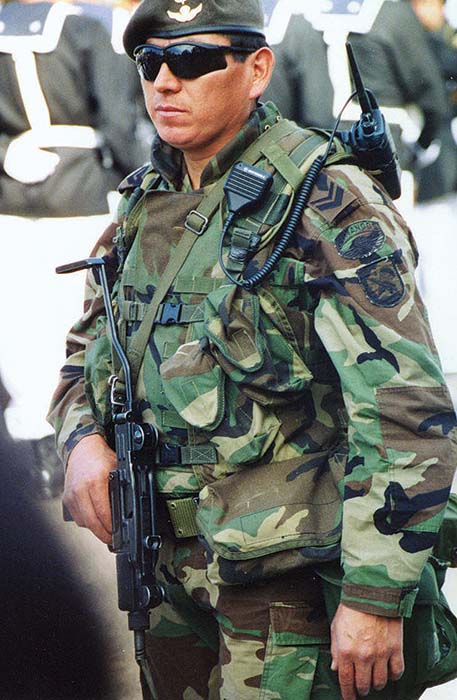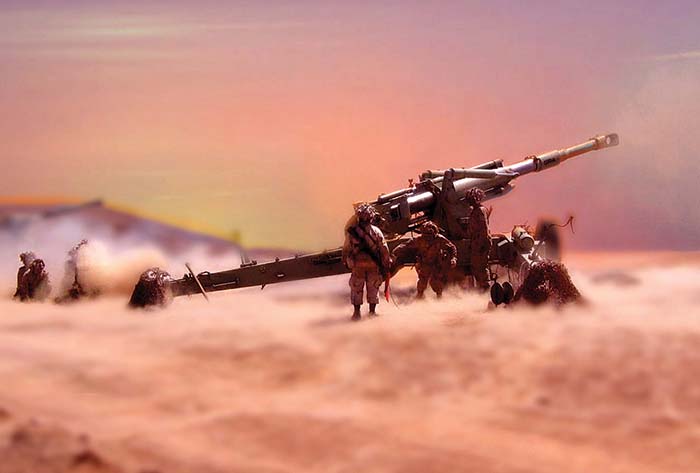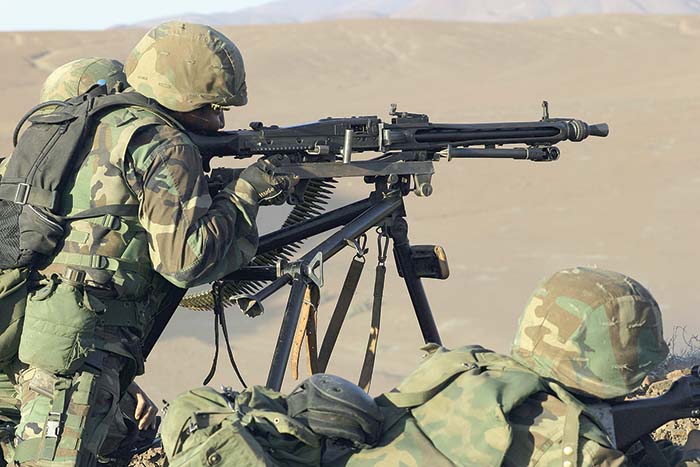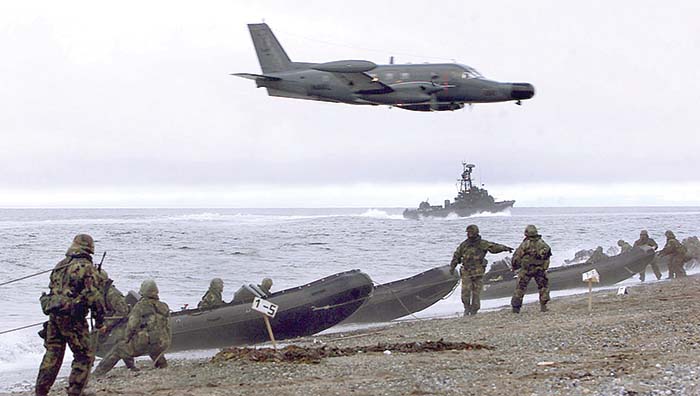Chilean Marines come ashore during an exercise. (Armada de Chile – ARCh)
By Julio A. Montes
Now celebrating the 190th anniversary of the national Marine Corps, the Chilean government has engaged in one of the most important and ambitious programs to modernize the maritime forces. It started with the purchase of a single Type-22 Batch II frigate from British surplus, followed by three Type-23s, plus two multi-purpose frigates and two air-defense frigates acquired in The Netherlands, with two off-shore patrol vessels being built in local yards. All this activity with the surface fleet could mean an increase in the Marine Corps ranks to allow for troops to serve more easily in two formations, and the Navy has already drawn plans to acquire and replace the amphibious ships. There are also plans for attack helicopters, much like the Super-Cobra AH-1Z. In addition to the elite Marines, the Navy is responsible for the Tactical Divers (Buzo Táctico), Naval Registry and Boarding Group (GARA – Grupo de Abordaje y Registro de la Armada), and the Immediate Response Group (GIR – Grupo de Respuesta Inmediata), which responds to Directemar (Chilean Coast Guard), a dependency of the Navy.
Marine Units
There are four Marine Garrison Security units, one for each Naval Zone (1st Valparaiso, 2nd Talcahuano, 3rd Punta Arenas and 4th Iquique). There is a small Marine detachment deployed to the Eastern Island. The Marines are distributed in detachments, which are equivalent to reinforced battalions, two of them tasked with amphibious assault, one more with coastal and field artillery, and another one tasked with training and operations. The Destacamento IM No. 1 Lynch is based at Punta Gruesa, Iquique. Destacamento IM No. 2 Miller, the largest of the Chilean Detachments, is based at Concón, and it is tasked with amphibious operations all over Chile. The Destacamento IM No. 3 Aldea is located at the Tumbes Peninsula, Talcahuano, while the Destacamento IM No. 4 Cochrane rests at Punta Arenas. The Agrupación de Comandos IM No. 51 is the unit tasked with Special Operations, and it has Concón as its base.

The No. 1 Coastal Defense Regiment Lynch was raised on July 31, 1946 under Supreme Decree 1397. Its name honors the National Hero Rear-Admiral Patricio Lynch Zaldivar. On July 15, 1964, the unit becomes the No. 1 Lynch Marine Detachment, and remains to this day basically as a Coastal Artillery Unit.

The No. 2 Miller Marine Detachment traces its origins to the No. 2 Coastal Defense Regiment. The unit became the No. 2 Carlos Condell Marine Detachment in 1962, and changing its name to the present No. 2 Miller Marine Detachment on January 5, 1967. The name comes from Lt. Col. Guillermo Miller, another hero during the times of Admirals Manuel Blanco Encalada and Cochrane.

The No. 3 Aldea Marine Detachment performs as a training regiment, providing for Basic Marine Training, Officer Marine Training, and even Coastal Artillery and Field Artillery Training. Its origins are traced to the Artillery Group existent until after WWI. By 1938 the Group became the Sergeant Aldea Coastal Defense Regiment. The name was in honor to 2nd Sergeant Juan de Dios Aldea Fonseca, who gave his life in the fighting of May 21, 1879. In 1964, the outfit became the No. 3 Aldea Marine Detachment, and on May 27, 1966, the Detachment was tasked with the Marine Recruiting Training Center (CIRCIM – Centro de Instrucción de Reclutas del Cuerpo de Infantería de Marina).
The No. 4 Cochrane Marine Detachment operates in the remote and harsh environment in the Chilean southern tip. Its origins are found in the 4th Marine Company established in Punta Arenas on December 31, 1949. Ten years later the unit became the No. 4 Punta Arenas Marine Battalion, and then it became the No. 4 Cochrane Marine Regiment on February 13, 1962. The name honors Lord Thomas Alexander Cochrane. Its present name was given in 1966.
The Marine Recon unit was established on January 1, 1986, receiving the designation of No. 51 Marine Commando Group. With the Chilean affinity to the British Royal Navy, they prefer a comparison to the Commanchio Group. However, they have been getting closer ties with the US Recon USMC counterparts by means of periodic combined training. They are tasked with beach reconnaissance, and behind the line operations. The commandos’ expert skills include scuba diving, airborne operations, amphibious and coastal raiding operations, demolitions, and mountaineering.
Marine HQ is retained at Valparaiso, where the main Naval Base is also located. The beautiful region of Concón, located several miles north from Vina del Mar, is home for many Marine outfits and is where we find the Marine Logistical Support Center.
The equivalent to the SBS role goes to the Tactical Divers (Buzo Táctico), which is under Naval Command, and more specifically under the Submarine Command. The Tactical Divers and the Marine Commandos have access to any type of weapons in the market. They appear to prefer the Micro-Uzi given its extreme compact size, and awesome firepower at close quarters. However, for most of the operations, the HK MP5 is ever present in all its variants. Another favorite is the locally designed and built MT-9 SAF chambered for 9mm, and the Mark 5 (L34A1) with integral sound suppressor is also used. Both, the MP-5K and mini-SAF are appreciated for their compactness and reliability in close quarter combat. The commandos prefer the P220 pistols, but some 1,500 M1911A1s were acquired in 1994. The SIG MP310 is another favorite.

Another small arm, more for its political statement than for anything else, is the AKM, used for particular tasks. The standard issued rifles are the HK33A3 and HK33A2 models, with the first 4,000 arriving in 1975. However, the HK33s are now being replaced with the M16A2 (AR- 15A2 Model R702), and this is in great part to the mentioned close ties that have developed lately with the USMC. Chile acquired the initial 5,500 M16A1 (AR-15A1 Model R613) in 1974, along with numbers of M16A2 Commandos (CAR-15A2 Model R735) with the short 290mm (11.42 in.) barrel length and retractable stock, and similar M4 Carbine (CAR-15A3 Model R977) with the 368mm (14.49 in.) barrel and MILSTD- 1913 rails.
For precision work, the AW from Accuracy International, Ltd. is a favourite, together with the HK MSG90. The Chileans acquired some 12 M21 rifles in 1994, and have purchased the Barrett Model 82A1M. Some Marines and commandos use the Mossberg 500 Cruiser.
Fire support comes from the Ultimax 100 Mk-III, MAG-60-20, HK-21, and M60, but the most widely distributed is the MG42/ 59 while the M2HB is mounted on tripods and pedestals. The Marines make good use of CIS 40GL, normally mounted under the HK-33A2, M79 GL and M203. The CIS 40AGL is placed on pedestals and tripods, as are the Mk-19 Mod 3 models. The 20mm KAA guns are used in flexible gun mounts on ships. One of the most recent acquisitions has been the Vektor AGL and Milkor MGL types. Mortars include the usual FAMAE MO-60AV and 81mm variants. AT teams use the M72A3, AT-4, and now the IWI Matador.

(Armada de Chile – ARCh)
Fighting Lineage
General Bernardo O‘Higgins Riquelme established the 1st Naval Squad (Marines) on June 16, 1818, and the first embarked riflemen came under the command of Mayor Guillermo Miller. The following year the Chilean Naval forces followed the lead of Admiral Lord Thomas Alexander Cochrane, with the Marines breaching the enemies’ defenses in the 1839 War between Chile and the Peruvian-Bolivian Confederation. The Marines performed amphibious operations during the Antofagasta Campaign in the 1870s, leading the way in Pisagua Port to the Army’s 1st Division. They fought bravely in Dolores, Tacna, Arica, Chorrillos and Miraflores. The Marine Corps came officially into being in 1964, and today they are ready and able to fight anywhere, anytime, in the defense of Chile.
| This article first appeared in Small Arms Review V11N4 (January 2008) |











